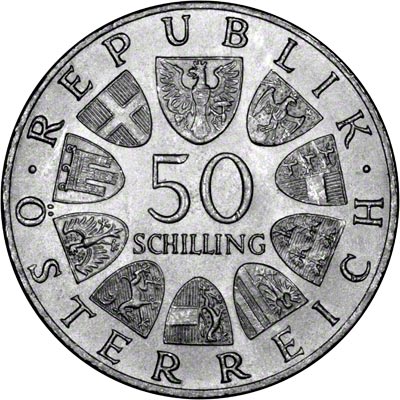| The Very Highest Quality Information... |
| Austria and Austrian Coins |
|
| ||||||||||||||||||||||||||||||||||||

| ||||||||||||||||||||||||||||||||||||
|
| ||||||||||||||||||||||||||||||||||||

| ||||||||||||||||||||||||||||||||||||
|
| ||||||||||||||||||||||||||||||||||||
Holy Roman Empire
Vienna, the capital of Austria, was long the seat of the Holy Roman Empire under the Habsburgs. The Holy Roman Empire was however, a fairly loose confederation of German states, of which Austria was merely the most important. The power of Austria and the Habsburgs did however decline, especially in the wake of the 30 Years War of 1618 to 1648. From the early 18th Century onwards, Prussia began to eclipse Austria as the most important German state.
The Early Napoleonic Wars went badly for the Holy Roman Emperor, Francis II, and many German territories were rested from Austrian control. In 1804, Francis II unilaterally abolished the Holy Roman Empire and founded the Austrian Empire in its place, with himself as Emperor Francis I.
Austrian Empire
After the final defeat of Napoleon in 1815, Metternich, Austria’s foreign minister played a large role in reshaping Europe, and securing Austria’s place as one of the great powers of Europe. Austria was placed in the role as the presiding state in the Confederation of Germany. However, the Habsburgs owned many lands outside of Germany, including Hungary and parts of the Balkans. In the face of rising German nationalism and moves towards German unification, this complicated Austria’s claim to be the capital of any future German nation.
In 1866, the Austro-Prussian war saw the defeat of Austria, which was subsequently thrown out of the German Confederation. The following year, Emperor Franz-Josef II finally bowed to the demands of his Hungarian subjects and made them a separate kingdom equal to Austria with control of its own internal affairs, but with a common foreign and military policy with Austria, the empire subsequently became known as the Austro-Hungarian Empire to reflect this change.
The Franco-Prussian war of 1870-71 saw Germany united under Prussian, rather than Austrian leadership.
World War One and the End of the Austro-Hungarian Empire
In August 1914, the heir to the Austro-Hungarian Empire, the Archduke Franz Ferdinand, was assassinated, along with his wife, by the Yugoslav nationalist Gavrilo Princip. This led to a series of events culminating in the First World War. Austria-Hungary found itself on the losing side of this conflict, and the last Emperor, Charles I abdicated and went into exile (interestingly, his son and the last crown prince of Austria died as recently as 2011).
The Austro-Hungarian Empire was dissolved in 1918 and Austria became one of the Empire’s successor states.
Republic of Austria
Initially, the new Republic named itself ‘German Austria’ in anticipation of unification with the new German Republic, however, the victorious allied powers forbade this, and so Austria became an independent nation. As with neighbouring Weimar Germany, Austria suffered heavily from hyperinflation, and Nazi sympathies rose to the surface. In 1934, the Anschluss saw Austria unified under Nazi Germany under the leadership of one of its natives, Adolf Hitler.
Nazi Germany
As a state of Nazi Germany, Austria was part of the Third Reich. As Nazi Germany started to lose the war, many Austrians were keen to once again assert their separate national identity, just as the allies were keen to separate Austria from any future German nation. Like Germany, Austria was divided into occupation zones by the French, British, Americans and Soviets.
Post War
As with most of the other countries occupied by the Soviets, the Soviets looted those areas under their control of their industrial assets and shipped them back home. However, despite demands from traitorous Austrian communists, the Soviets refused to partition Austria as they had done with Germany, and having received assurances that Austria would remain neutral and forbid foreign bases on Austrian soil, the Soviets withdrew in 1955 and Austria was made fully independent.
Austrian Coins
The history of Austrian coinage is a complicated one. The Holy Roman Empire used a variety of different standards. The Austrian Empire, prior to decimalisation in 1857 used a system consisting of:
8 Heller = 4 Pfennig = 1 Kreuzer
60 Kreuzer = 1 Florin
2 Florin = 1 Specie (later Convention) Thaler
Following decimalisation in 1857, Austria issued a new currency called the Gulden (or Florin) subdivided into 100 new Kreuzer. This currency was itself replaced in 1892 when Austria-Hungary adopted the gold standard. The Gulden was replaced by the Krone at 2 Kronen = 1 Gulden. The new subunit was the Heller.
After wartime and post-war hyperinflation, the Krone was replaced by the Schilling at 1 Schilling = 10,000 Kronen. The subunit of the Schilling was the Groschen. This first Schilling was abolished following the Anschluss and replaced by the Reichmark at 2 RM = 3 Schilling. The Schilling was reborn after World War II, and lasted until 2001, when it was replaced by the Euro.
Perhaps the most famous Austrian coin is the Marie-Theresa Thaler. Struck to the Conventionsthaler standard, this silver coin consists of 0.833 fine silver and cointains 0.7515 oz of silver. Restrikes of the 1780 are still produced by the Austrian Mint as a silver bullion coin, along with the 1 oz silver Philharmonic issues. The Thaler was and still is a popular trade coin in the Middle East, along with the British gold Sovereign.
For Sale and Wanted
If you are interested in coins from Austria please see our product index:-
Austrian Coins
Gold Coins
We also have gold coins from Austria on our taxfreegold website:-
Austrian Gold Coins
| ...at the Lowest Possible Price |
|
32 - 36 Harrowside, Blackpool, Lancashire, FY4 1RJ, England.
Telephone (44) - (0) 1253 - 343081 ; Fax 408058; E-mail: info@chards.co.uk The URL for our main page is: https://24carat.co.uk |
Web Design by Snoop |